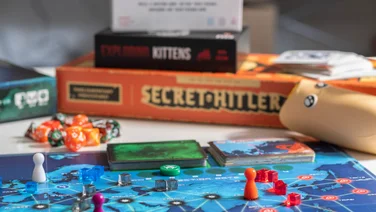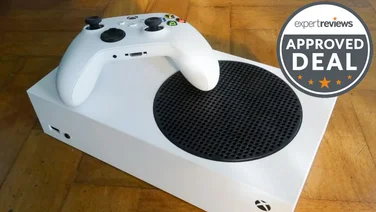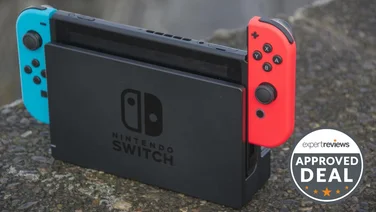To help us provide you with free impartial advice, we may earn a commission if you buy through links on our site. Learn more


















- Amazingly easy to set up
- Great value now Oculus Touch is included
- Access to some of the best VR games
- PC requirements still aren't widely accessible
- Isn't room scale out-of-the-box
- Can't use your own headphones
Deal update: While the Oculus Rift’s RRP permanently dropped to £399 earlier this year, you’ll benefit from an extra £50 discount for a limited time at Argos. Bringing the price down to £349, the Oculus Rift VR headset will make a fantastic gift this Christmas but you’ll have to move fast as there’s no telling how long this deal will last.
Our original review continues below:
Oculus Rift has been the poster-boy of VR since its initial Kickstarter campaign back in 2012. Five years on, a lot has changed in the VR landscape Oculus Rift has been on the market for over a year, its chief rival, the HTC Vive has come out swinging, and Sonys console-exclusive PlayStation VR has provided healthy competition.
In the year since its March 2016 release, Oculus has turned the Rift from a seated VR experience to a standing interactive system with Oculus Touch. Its also expanded to offer support for HTC Vive-like room scale VR.
Of the three headsets, its clear the Facebook-owned company is focusing on game-first VR experiences. Sonys PlayStation VR is doing its own thing, well away from Oculus core audience, while HTC is going down the smart route of turning Vive into an enterprise proposition instead of a consumer device.
So, now that were more than a year into Oculus Rifts life, its time to take a look at what your hard-earned money can get you when picking up an Oculus Rift today.
READ NEXT: Best VR Headset 2017
Oculus Rift review: Design
Of all three of the major VR headsets on the market, its easy to say that Oculus Rift is aesthetically the best of the bunch. Thats not particularly hard when its competition is a bulbous, pock-marked mushroom and the other looks like something right out of a 1970s sci-fi film.

Regardless, Oculus attention to detail with the Rifts design is spot on. The main body that houses the lenses and displays is wrapped in a soft, yet rugged, black fabric. Its a subtle design decision, especially when it looks like matte plastic from afar, but it adds a touch of warmth to the Rift it doesnt look like a toy like PlayStation VR can do, it looks like a premium piece of technology.
Oculus Rift also employs a rather handy baseball cap system for taking it on and off. While Vive requires you to put the main unit to your face and pull the ski-goggle strap back over your head, Rift asks you to put it on over the back of your head and pull the headset over your eyes. Its simple enough to do and comfortable to take on and off with ease although anyone who says you can wear it comfortably with glasses clearly hasnt worn a pair of glasses in their life.
In terms of design, the only criticism Id have to level at the Oculus Rift is its built-in on-ear headphones. Its handy not having to fumble around for a pair of earbuds or over-ear headphones with your headset on, but they do always seem to get in the way and dont feel overly comfortable to have perched on your ear. Oculus does offer an option to switch them out for its alternative built-in earbuds, which arent included in the box. The general sound quality is pretty impressive if not slightly over loud but theyre just not really for me.


















Oculus Rift review: Specifications
In terms of headset hardware specifications, the Oculus Rift is practically identical to that of the HTC Vive. Both have 110-degree viewing angles, twin 1,200 x 1,080-pixel OLED displays and a 90Hz refresh rate. The difference in visual clarity also seems to be down to personal preferences with some of us in the team preferring the Rifts lenses to that of the Vive. Im a Vive man: while both are almost completely indistinguishable from one another, Vives lenses and brighter display deliver a crisper image to my eye than that of the Rift but its not enough to be anything near a deal-breaker even PlayStation VRs lower resolution display is perfectly fine for playing games with.
One thing the Oculus Rift does have going for it over the HTC Vive is its lower minimum system requirements. The HTC Vive needs at least an Nvidia GTX 970 to run, along with an Intel Core i5-4590, but thanks to AMDs Asynchronous Spacewarp technology, Oculus Rift can actually run on an Intel Core i3-6100 or AMD FX4350, Nvidia GTX 960 or Radeon R9 290 and 8GB of RAM.
Despite that low requirement, we actually decided to test our Oculus Rift on the best possible kit we could find, the Acer Predator 21X. It was a little overkill with its SLI GTX 1080 cards, but it did the job.
Oculus Rift review: Setup
Youll be pleased to know that Oculus Rift is actually rather straightforward in terms of initial setup. Thanks to the lack of Lighthouse beacons, and no need to put out a separate feed from your computer to a TV, it actually has fewer cables than both the HTC Vive and PlayStation VR. Because of this, you can simply plug in the tracking cameras you have into USB 2 or USB 3 ports the software detects if you have one, two or three cameras hooked in and follow the on-screen instructions. In total, setting up for standing play with Oculus Touch took around ten minutes once all drivers were installed Room Scale took a little longer due to optimising camera positions but was no longer than 15 to 20 minutes.

Once youre good to go, youll go through Oculus mandatory introductory session. It thrusts you into a Ready Player One-style ramshackle caravan in the far-flung future filled with old-school computers and holographic displays. As introductions go, its a great way to familiarise yourself with the Touchs ability to grab or poke or throw objects around a virtual space.
Unfortunately, its seemingly unstoppable and, after setting up the Rift more than once, it becomes tiresome rather quickly. Still, it is entertaining.
Oculus Rift review: Games and Apps
To ensure that theres more than enough VR content available to justify the purchase of its own headset, Oculus has really been pushing the boundaries of VR games and applications available for Rift. Its thanks to this development and publishing arm that Oculus Rift has some genuinely incredible exclusives available to it.
Lone Echo, developed by Ready At Dawn, and Epic Games Robo Recall are two of the best examples of this partnership. Robo Recall is an excellent example of how to use Oculus Touch to engage with the world around you, tearing the limbs off robots and throwing back bullets at your artificial opponents.
Lone Echo, however, takes a different tact of immersion. Using Oculus Touch and utilising its room-scale capabilities, it eases you into a life of navigating your way around a zero-gravity environment. Its a glorious feeling, and one that becomes increasingly natural the longer you stay immersed in the Rift headset.
READ NEXT: Best VR Games 2017
There are plenty more Oculus Rift exclusives to pick up, all of which make excellent use of Oculus VR technology to create stunning games to immerse yourself within. However, even multi-platform games like SuperHot VR, Keep Talking and Nobody Explodes, EVE: Valkyrie and more all play wonderfully on the Rift.
Its VR interface, which takes place within a virtual home, is pleasingly comfortable to navigate through and doesnt feel as bleak as the HTC Vives interface nor as cumbersome as PlayStation VRs 2D PS4 menu. The Oculus Store highlights games of interest and jumping around simply requires you to point and click, rather than flick through a series of menus. Its genuinely intuitive.
Its in these small details that you can really see how Oculus is positioning itself. The HTC Vive is more functional and has fewer bells and whistles going on in its VR space or Steam navigation. Its clearly a headset aimed at a commercial market rather than your average consumer. Oculus Rift, however, is here for the people. Its the PC version of PlayStation VR its all about the games. Sony can get away with some rough edges to its PlayStation VR experience but, as Oculus Rifts premium price means premium expectations, it has to deliver. Thankfully, it seems to do just that.
Oculus Rift review: Oculus Touch
Now every Oculus Rift purchase comes with a free Oculus Touch via a £99 discount when bought together, it seems somewhat silly to talk about the Rift as anything but a Touch-enabled experience. But many early Oculus Rift owners only received their Rift with an Xbox One controller for Windows 10 and Oculus Touch is a world apart from the now archaic gamepad.


















Looking somewhat like tools from the future, Oculus Touchs handheld controllers have a main grip with two triggers, and a ring of plastic protecting your fist from smacking into something rather hard while holding a Touch controller. As a general tracking tool, theyre as accurate as HTC Vives plastic wands but are definitely more comfortable to hold for longer durations and actually have some rather clever bits of technology packed within.
Each Oculus Touch controller has a thumbstick for traditional controller navigation, along with A, B, Y, X face buttons split between your left and right hands. The face of each Touch controller also has a menu and Oculus button which work like the navigation and Start buttons on an Xbox One pad and is capable of sensing if your thumb is touching the surface or is raised up. The main index-finger trigger can do similar, capable of telling if you’re pointing or gripping the trigger ahead of clenching a fist.
Being able to track these movements seems somewhat pointless on paper, but in VR its revelatory. Thanks to Oculus Touch, Oculus Rift is the only VR headset capable of letting you interact with virtual worlds via pointing or using gestures like thumbs up or clenched fists. Few games are yet to make any use of this, but its great for a VR social spaces like Facebooks Spaces application.
Oculus Touch also runs on AAA batteries that, so far, have lasted quite a while of use. Comparatively, the HTC Vive and PlayStation Move controllers internal batteries seem to run down woefully quickly.

Oculus Rift review: Verdict
If you like games, and you only see owning a VR headset as a gateway to playing more games rather than VR experiences, Oculus Rift is for you. Its got a fantastic catalogue featuring some of the best VR games around and, because Oculus works directly as a VR games publisher and with game development, many VR titles feel fantastic to play with an Oculus Rift.
The trouble arises when you want something more from the Rift. Facebook Spaces is a great little social experiment, but its lacking some of the more interesting elements found in experimental social spaces like Metaworld on the HTC Vive, and is unlikely to be a system seller in its own right. Oculus VR has also dabbled in VR film and animation productions, but as that arm of the business has been shuttered its unlikely well see more of those interesting project arise from within the studio.
However, despite those little niggles, its clear that Oculus Rift represents one of the best value-for-money purchases in the VR hardware space. At its now permanent price of £399 its almost a must-buy for those interested in VR – significantly cheaper than the now similar £600 HTC Vive.
The only trouble is, now were a year on from release, you have to start wondering whats coming next. We already know Oculus is working on a wireless version of the Rift to sit between the Gear VR and Rift headsets in terms of functionality, but could next year see the arrival of a true Oculus Rift successor something offering up a minimum of 2K resolutions per eye? Thats a gamble youll have to make, but it seems that now is as good a time as any to pick up an Oculus Rift.







